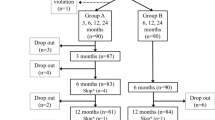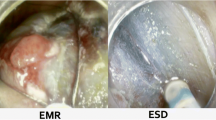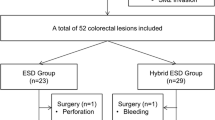Abstract
Background/Aim
Endoscopic treatments of colorectal neoplasms have yet to be standardized. This study aimed to compare efficacy and tolerability of different endoscopic resection methods for colorectal epithelial tumors.
Methods
Patients with non-pedunculated colorectal tumors undergoing endoscopic treatments were consecutively enrolled, and their medical records were reviewed retrospectively. The resection methods were classified into three groups: endoscopic mucosal resection with circumferential precutting (EMR-P), endoscopic submucosal dissection with snaring (ESD-S), and endoscopic submucosal dissection alone (ESD). We compared en bloc resection, pathological complete resection, and complications associated with these methods.
Results
Overall, 206 lesions from 203 patients were included in the study (mean size 25.2 ± 10.1 mm). The number of lesions treated with EMR-P, ESD-S, and ESD was 91 (44.2 %), 57 (27.7 %), and 58 (28.2 %), respectively. There was a significant difference in both the en bloc resection rates (EMR-P, 61.5 %; ESD-S, 64.9 %; ESD, 96.6 %; p = 0.001) and complete resection rates (EMR-P, 51.6 %; ESD–S, 54.4 %; ESD, 75.9 %; p = 0.009). Bleeding and perforation were less frequently observed in the EMR-P group. In the subgroup-analysis of lesions less than 20 mm, however, these differences were not observed.
Conclusions
All endoscopic resection methods, including EMR-P, ESD-S, and ESD, were effective and safe for the treatment of colorectal neoplasms. Technically demanding ESD with high en bloc and complete resection rate should be reserved for the suspicious cancer lesion, which requires the precise histological evaluation. EMR-P with good feasibility can be considered an alternative to ESD for the lesions less than 20 mm.




Similar content being viewed by others
References
Bergmann U, Beger HG. Endoscopic mucosal resection for advanced non-polypoid colorectal adenoma and early stage carcinoma. Surg Endosc. 2003;17:475–479.
Conio M, Repici A, Demarquay JF, et al. EMR of large sessile colorectal polyps. Gastrointest Endosc. 2004;60:234–241.
Fujishiro M. Endoscopic submucosal dissection for stomach neoplasms. World J Gastroenterol. 2006;12:5108–5112.
Gotoda T, Yamamoto H, Soetikno RM. Endoscopic submucosal dissection of early gastric cancer. J Gastroenterol. 2006;41:929–942.
Toyanaga T, Man IM, Ivanov D, et al. The results and limitations of endoscopic submucosal dissection for colorectal tumors. Acta Chir Iugosl. 2008;55:17–23.
Muto M, Miyamoto S, Hosokawa A, et al. Endoscopic mucosal resection in the stomach using the insulated-tip needle-knife. Endoscopy. 2005;37:178–182.
Min BH, Lee JH, Kim JJ, et al. Clinical outcomes of endoscopic submucosal dissection (ESD) for treating early gastric cancer: comparison with endoscopic mucosal resection after circumferential precutting (EMR-P). Dig Liver Dis Off J Italian Soc Gastroenterol Italian Assoc Study Liver. 2009;41:201–209.
Byeon JS, Yang DH, Kim KJ, et al. Endoscopic submucosal dissection with or without snaring for colorectal neoplasms. Gastrointest Endosc. 2011;74:1075–1083.
Kim ES, Cho KB, Park KS, et al. Factors predictive of perforation during endoscopic submucosal dissection for the treatment of colorectal tumors. Endoscopy. 2011;43:573–578.
Goto O, Fujishiro M, Kodashima S, et al. Feasibility of electrocautery snaring as the final step of endoscopic submucosal dissection for stomach epithelial neoplasms. Dig Liver Dis Off J Italian Soc Gastroenterol Italian Assoc Study Liver. 2009;41:26–30.
Nishiyama H, Isomoto H, Yamaguchi N, et al. Endoscopic submucosal dissection for colorectal epithelial neoplasms. Dis Colon Rectum. 2010;53:161–168.
[Anonymous]. General rules for clinical and pathological studies on cancer of the colon, rectum and anus. Part II. Histopathological classification. Japanese Research Society for Cancer of the Colon and Rectum. Japanese J Surg. 1983; 13:574–598.
Uraoka T, Saito Y, Matsuda T, et al. Endoscopic indications for endoscopic mucosal resection of laterally spreading tumours in the colorectum. Gut. 2006;55:1592–1597.
Kudo S. Endoscopic mucosal resection of flat and depressed types of early colorectal cancer. Endoscopy. 1993;25:455–461.
Schlemper RJ, Riddell RH, Kato Y, et al. The Vienna classification of gastrointestinal epithelial neoplasia. Gut. 2000;47:251–255.
Iishi H, Tatsuta M, Narahara H, et al. Endoscopic resection of large pedunculated colorectal polyps using a detachable snare. Gastrointest Endosc. 1996;44:594–597.
Matsuda T, Gotoda T, Saito Y, et al. Our perspective on endoscopic resection for colorectal neoplasms. Gastroenterol Clin Biol. 2010;34:367–370.
Toyonaga T, Man IM, Morita Y, et al. The new resources of treatment for early stage colorectal tumors: EMR with small incision and simplified endoscopic submucosal dissection. Dig Endosc Off J Japan Gastroenterol Endosc Soc. 2009;21:S31–S37.
Seo HJ, Kim YJ, Cho KB, et al. Nodal metastasis after successful endoscopic submucosal dissection for colorectal mucosal cancer. Endoscopy. 2011;43:E374–E375.
Watanabe K, Ogata S, Kawazoe S, et al. Clinical outcomes of EMR for gastric tumors: historical pilot evaluation between endoscopic submucosal dissection and conventional mucosal resection. Gastrointest Endosc. 2006;63:776–782.
Zhou PH, Yao LQ, Qin XY. Endoscopic submucosal dissection for colorectal epithelial neoplasm. Surg Endosc. 2009;23:1546–1551.
Puli SR, Kakugawa Y, Saito Y, et al. Successful complete cure en bloc resection of large nonpedunculated colonic polyps by endoscopic submucosal dissection: a meta-analysis and systematic review. Ann Surg Oncol. 2009;16:2147–2151.
Fujishiro M. Endoscopic submucosal dissection for colorectal neoplasms. World J Gastrointest Endosc. 2009;1:32–38.
Fujishiro M, Yahagi N, Kakushima N et al. Outcomes of endoscopic submucosal dissection for colorectal epithelial neoplasms in 200 consecutive cases. Clin Gastroenterol Hepatol Off Clin Pract J Am Gastroenterol Assoc. 2007; 5:678–683 (quiz 645).
Tanaka S, Oka S, Kaneko I, et al. Endoscopic submucosal dissection for colorectal neoplasia: possibility of standardization. Gastrointest Endosc. 2007;66:100–107.
Conflict of interest
None.
Author information
Authors and Affiliations
Corresponding author
Additional information
Yun Jung Kim and Eun Soo Kim contributed equally to this work.
Rights and permissions
About this article
Cite this article
Kim, Y.J., Kim, E.S., Cho, K.B. et al. Comparison of Clinical Outcomes Among Different Endoscopic Resection Methods for Treating Colorectal Neoplasia. Dig Dis Sci 58, 1727–1736 (2013). https://doi.org/10.1007/s10620-013-2560-x
Received:
Accepted:
Published:
Issue Date:
DOI: https://doi.org/10.1007/s10620-013-2560-x




